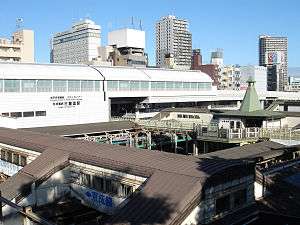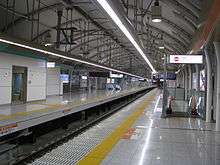Nippori Station
Nippori Station 日暮里駅 | |
|---|---|
 Elevated view of Nippori station, September 2009 | |
| Location |
2 Nishi-Nippori, Arakawa-ku, Tokyo (東京都荒川区西日暮里二丁目) Japan |
| Operated by | |
| Line(s) | |
| Connections |
|
| Other information | |
| Station code |
|
| History | |
| Opened | 1905 |
| Traffic | |
| Passengers (JR East, FY2013) | 102,817 daily |
Nippori Station (日暮里駅 Nippori-eki) is a major railway interchange station in Arakawa, Tokyo, Japan.
A new elevated platform for Keisei services opened on October 3, 2009.
Lines
The station is an intersection of JR and Keisei systems. Although Keisei Ueno Station, the terminal of Keisei, is also located adjacent to JR East's Ueno Station, Nippori Station provides easier transfer.
Platforms
Keisei platforms

A new elevated platform serving outbound Keisei trains opened to traffic on October 3, 2009. The new elevated line has two side platforms serving a single track. One platform is for Skyliner, Cityliner, and Eveningliner boarding, while the other platform is for regular commuter trains. Ueno-bound trains continue to discharge on the original platform on the lower level.
| 0 | ■ Keisei Main Line | to Keisei-Ueno |
| 1 | ■ Narita Sky Access | for Narita Airport (Skyliner trains) |
| ■ Keisei Main Line | for Keisei-Funabashi, Keisei-Narita and Narita Airport (Cityliner and Eveningliner trains) |
|
| 2 | ■ Narita Sky Access | for Aoto, Keisei-Takasago, the Hokuso Line and Narita Airport (Access Express trains) |
| ■ Keisei Main Line | for Aoto, Keisei-Funabashi, Narita Airport and Keisei Chiba (Local, Rapid, Commuter Express, and Limited Express trains) |
JR platforms
There are no platforms for tracks 5 to 8, which are for non-stop Takasaki Line and Utsunomiya Line trains.
| 3 | ■ ■Joban Line (Rapid service) | to Ueno, Tokyo and Shinagawa |
| 4 | ■ ■Joban Line (Rapid service) and Narita Line | for Kita-Senju, Matsudo, Toride, Narita, Tsuchiura and Mito |
| 9 | ■ Keihin-Tohoku Line | for Ueno, Tokyo, Shinagawa and Yokohama |
| 10 | ■ Yamanote Line (clockwise) | for Ueno and Tokyo |
| 11 | ■ Yamanote Line (anti-clockwise) | for Ikebukuro and Shinjuku |
| 12 | ■ Keihin-Tōhoku Line | for Tabata, Akabane and Ōmiya |
Nippori-Toneri platforms
The Nippori-Toneri Liner station is elevated and consists of a single island platform serving two tracks.
Adjacent stations
| « | Service | » | ||
|---|---|---|---|---|
| Yamanote Line (JY07) | ||||
| Uguisudani (JY06) | - | Nishi-Nippori (JY08) | ||
| Keihin-Tohoku Line (JK32) | ||||
| Rapid: Does not stop at this station[1] | ||||
| Uguisudani (JK31) | Local | Nishi-Nippori (JK33) | ||
| Joban Line (Rapid) (JJ02) | ||||
| Ueno (JJ01, UEN) | Special Rapid | Kita-Senju (JJ05) | ||
| Ueno (JJ01, UEN) | Rapid | Mikawashima (JJ03) | ||
| Keisei Main Line (KS02) | ||||
| Keisei Ueno (KS01) | Skyliner | Narita Airport Terminal 2·3 (KS41) | ||
| Keisei Ueno (KS01) | Morningliner Eveningliner |
Aoto (KS09) | ||
| Keisei Ueno (KS01) | Access Express | Aoto (KS09) | ||
| Keisei Ueno (KS01) | Limited Express | Aoto (KS09) | ||
| Keisei Ueno (KS01) | Limited Express | Aoto (KS09) | ||
| Keisei Ueno (KS01) | Commuter Express | Aoto (KS09) | ||
| Keisei Ueno (KS01) | Rapid | Senjuōhashi (KS05) | ||
| Keisei Ueno (KS01) | Local | Shim-Mikawashima (KS03) | ||
| Nippori-Toneri Liner (01) | ||||
| Terminus | - | Nishi-Nippori (02) | ||
History
The JR station first opened on April 1, 1905.[2] The Keisei station opened on December 19, 1931.[3]
Passenger statistics
In fiscal 2013, the JR East station was used by an average of 102,817 passengers daily (boarding passengers only), making it the 37th-busiest station operated by JR East.[4] In fiscal 2013, the Keisei station was used by an average of 96,428 passengers per day (exiting and entering passengers), making it the third-busiest station operated by Keisei.[5] Over the same fiscal year, the Toei station was used by an average of 20,421 per day (boarding passengers only), making it the busiest station on the Nippori-Toneri Liner.[6] The daily average passenger figures (boarding passengers only) for the JR East station in previous years are as shown below.
| Fiscal year | Daily average |
|---|---|
| 2000 | 77,469[7] |
| 2005 | 78,921[8] |
| 2010 | 96,633[9] |
| 2011 | 96,747[10] |
| 2012 | 99,875[11] |
| 2013 | 102,817[4] |
Surrounding area
- Yanaka Cemetery
- Yanaka-Ginza Shopping District
- Yūyake-dandan Stairs
- Fujimizaka Hill
- Tokyo Women's Medical University Medical Center East
See also
References
- ↑ http://www.jreast-timetable.jp/1308/timetable/tt1184/1184050.html
- ↑ "JR East station information" (in Japanese). Japan: East Japan Railway Company. Retrieved 3 May 2011.
- ↑ Terada, Hirokazu (July 2002). データブック日本の私鉄 [Databook: Japan's Private Railways]. Japan: Neko Publishing. p. 203. ISBN 4-87366-874-3.
- 1 2 各駅の乗車人員 (2013年度) [Station passenger figures (Fiscal 2013)] (in Japanese). Japan: East Japan Railway Company. Retrieved 14 September 2014.
- ↑ 駅別乗降人員 [Passenger statistics for each station] (in Japanese). Keisei Electric Railway. Retrieved 14 September 2014.
- ↑ 各駅乗降人員一覧 [Passenger statistics for each station] (in Japanese). Tokyo Metropolitan Bureau of Transportation. Retrieved 14 September 2014.
- ↑ 各駅の乗車人員 (2000年度) [Station passenger figures (Fiscal 2000)] (in Japanese). Japan: East Japan Railway Company. Retrieved 1 August 2013.
- ↑ 各駅の乗車人員 (2005年度) [Station passenger figures (Fiscal 2005)] (in Japanese). Japan: East Japan Railway Company. Retrieved 1 August 2013.
- ↑ 各駅の乗車人員 (2010年度) [Station passenger figures (Fiscal 2010)] (in Japanese). Japan: East Japan Railway Company. Retrieved 1 August 2013.
- ↑ 各駅の乗車人員 (2011年度) [Station passenger figures (Fiscal 2011)] (in Japanese). Japan: East Japan Railway Company. Retrieved 1 August 2013.
- ↑ 各駅の乗車人員 (2012年度) [Station passenger figures (Fiscal 2012)] (in Japanese). Japan: East Japan Railway Company. Retrieved 14 September 2014.
External links
| Wikimedia Commons has media related to Nippori Station. |
Coordinates: 35°43′39″N 139°46′15″E / 35.727588°N 139.770781°E